

 |
||
| Witness the desert after
a shower or a garden after a much needed rain. Water gives and sustains
life, but it can also be a source of unseen pollution and deadly bacteria.
Even in the United States, the danger can be very close to home ...
as close as the nearest river or local beach. Municipal sewer systems have been a valuable part of the nation's infrastructure since the late 1800s. Prior to the advent of these systems, wastewater festered in privy vaults or cesspools, and storm water cascaded through city streets. As the country's population swelled, particularly in urban areas, so did its need for sanitary systems. Thriving cities and towns were frequently faced with flooding concerns and, more important, public health problems, because they could not handle the influx. In the sewer system of early Chicago, for example, gutters served as drains. As the city grew, engineers used underground pipes to route the wastewater directly into Lake Michigan, but its inhabitants continued to be plagued by disease. The cholera epidemic of 1854 decimated more than five percent of the city's population, and deaths from typhoid and dysentery continued to rise. The situation was urgent. In 1887 Rudolph Hering, chief engineer of the city's drainage and water supply commission, proposed digging a canal at the south branch of the Chicago River that would carry wastewater away from Lake Michigan and down the Mississippi River, via the Des Plaines and Illinois rivers. The Metropolitan Sanitary District of Greater Chicago was formed as a result of this plan. By 1900 the 28-mile canal Hering envisioned was complete. It became known as the Sanitary and Ship Canal, and by 1908, it had resulted in a 91 percent drop in the rate of typhoid deaths in the city. When it was created Chicago's sanitary district covered 185 square miles of the city and some of the western suburbs. In 1955 the American Society of Civil Engineers recognized the city's efforts by selecting the sanitary district as one of the seven engineering wonders in the U.S. Today, the district is comprised of 858 square miles, including nearly all of Cook County. It serves Chicago, 114 smaller cities and villages, and 20 local sanitary districts. But portions of the district, like much of the nation’s wastewater infrastructure, are at risk.  Of the more than 16,200 wastewater treatment facilities and 21,200
sewer systems serving the U.S. -- approximately 725,000 miles
of publicly-owned pipes and 500,000 miles of privately-owned pipes
-- the average age of sewer system components ranges from new to 117
years old. But age is not the only consideration when discussing water
treatment issues. Of the more than 16,200 wastewater treatment facilities and 21,200
sewer systems serving the U.S. -- approximately 725,000 miles
of publicly-owned pipes and 500,000 miles of privately-owned pipes
-- the average age of sewer system components ranges from new to 117
years old. But age is not the only consideration when discussing water
treatment issues. According to the Environmental Protection Agency (EPA), cities typically employ one of two types of sewer systems: a combined sewer system (CSS) or sanitary sewer system (SSS). A CSS is a system that carries wastewater and storm runoff through a single pipe to a treatment facility. However, when the flow in the pipes exceeds the capacity of the system, water -- wastewater, groundwater, and storm water -- is discharged directly into rivers or other local bodies of water. This event is called a combined sewer overflow (CSO). An SSS collects and conveys wastewater along with limited amounts of groundwater and storm water to a treatment plant. A separate pipeline in the system handles storm runoff. SSSs can have overflows (SSOs) like a CSO event, but these are typically due to blockages, structural or mechanical failure, collapsed pipes, or vandalism. Both types of systems exist, in part, because CSSs were less expensive for cities that needed both sanitary and storm sewers. CSS pipes were constructed to be able to handle the wastewater of a community, as well as a specified amount of runoff from heavy storms -- typically three to five times the average dry weather flow. SSSs were more practical and less expensive for cities that only needed a wastewater collection system; these systems were not constructed to hold runoff from storms. Because of this, large cities tended to construct CSSs. During the latter part of the 19th century, construction of CSSs improved local sanitary conditions. But the rate of disease-related deaths in downstream cities remained constant, highlighting the need for more advanced wastewater treatment and the major design difference between the CSSs and SSSs. Although state and local governments have not constructed new CSSs since the first half of the 20th century, there are 772 cities that employ a CSS for wastewater treatment. These cities serve more 40 million people in the northeast and Great Lakes regions of the country, particularly the District of Columbia, Illinois, Indiana, Maine, Michigan, New York, Ohio, Pennsylvania, and West Virginia. The EPA has estimated that CSOs release approximately 850 billion gallons of untreated wastewater and storm water annually. SSOs account for the release of between three and 10 billion gallons of untreated wastewater each year. Since all cities with a CSO problem are under a federal mandate from the EPA -- the National CSO Control Policy of 1994, they must take corrective action to minimize the adverse effects of CSO events on water quality, aquatic life, and human health or face heavy fines. Unfortunately, correcting the problem is neither a quick nor an inexpensive fix. In its August 2004 Report to Congress on the Impact and Control of CSOs and SSOs, the EPA discusses technologies that may be suited to address the issue. However, many of the "remedies" come with a price tag that most cities simply cannot afford. "Typical solutions to the CSO problem involve large and expensive civil engineering projects that would enhance the sewer infrastructure of metropolitan areas," says Jeffrey W. Talley, assistant professor of civil engineering and geological sciences. Citing South Bend, the fourth largest city in Indiana, with a population of 107,789, Talley explains that if South Bend employed current technology, the city would have to spend $200 million dollars over the next 20 years to fix its CSO problem. Indianapolis, another city with a CSS, would need to spend $1 billion. According to Talley, the monetary measurements are just the tip of the iceberg. "Consider the amount of disruption to local businesses and traffic patterns in a major engineering project of this type," he says. "In studying the many facets of this problem, we felt there had to be a better way to improve water quality without busting a city's budget or inconveniencing its citizens, and we may have found it." Talley is leading a team of academic, industry, and municipal researchers in a project that may help solve the CSO problem. The team, which includes Notre Dame colleagues Michael D. Lemmon, professor of electrical engineering; Patricia A. Maurice, professor of civil engineering and geological sciences and director of the Center for Environmental Science and Technology; Lloyd H. Ketchum Jr., associate professor of civil engineering and geological sciences; and Agnes E. Ostafin, assistant professor of chemical and biomolecular engineering, partners with the cities of South Bend, Mishawaka, and Elkhart and with 20 other researchers from Purdue University, the Environmental Health Laboratories of South Bend, Greeley and Hansen LLC, EmNet LLC, and the CSO Partnership of Richmond, Va. Their work is being funded via a $1 million grant from the Indiana 21st Century Research and Technology Fund. Created in 1999, the 21st Century Fund supports research that pairs academia and industry as they explore, develop, and commercialize advanced technologies within Indiana. Notre Dame has received several grants from the fund for a variety of projects having the potential to diversify the state's economy. This most recent grant is tied to the fact that more than 20 billion gallons of sewage are released into Indiana streams each year as a result of CSO events within the state. The development of technology to prevent the overflow, while stimulating the creation of new business opportunities in the state, supports the purpose for which the fund was created. |
||
|
||
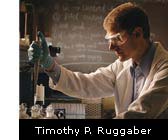 Initially addressing issues
specific to the South Bend area, Talley's team is defining innovative
technologies that could impact all CSO plagued cities. "Like
most CSO cities," says Talley, "South Bend has a 'passive' sewer
system. Diversion structures, or weir walls, physically divert wastewater
and storm runoff when water levels exceed set parameters." This
means that during wetter than normal conditions, wastewater can flow
over the weir walls directly into local waterways. Currently, municipalities
have no way of tracking wastewater levels within sewer systems. Talley
and the research team are proposing the use of an embedded wireless
sensor network (EmNet) to accomplish this task. Initially addressing issues
specific to the South Bend area, Talley's team is defining innovative
technologies that could impact all CSO plagued cities. "Like
most CSO cities," says Talley, "South Bend has a 'passive' sewer
system. Diversion structures, or weir walls, physically divert wastewater
and storm runoff when water levels exceed set parameters." This
means that during wetter than normal conditions, wastewater can flow
over the weir walls directly into local waterways. Currently, municipalities
have no way of tracking wastewater levels within sewer systems. Talley
and the research team are proposing the use of an embedded wireless
sensor network (EmNet) to accomplish this task. EmNet, as envisioned by the team, would consist of a series of small sensors controlled by microprocessors and run by solar energy or battery power. The individual sensors and nodes in the network would communicate with one another, routing information between themselves to an information base station and eventually to "smart" valves which could re-route the wastewater. Since the network acts with distributed memory and a distributed database, all information occurs in real-time, meaning that city engineers monitoring the system could make informed decisions concerning the control of the system and alert citizens as an event was occurring. An additional benefit is that municipalities would be able to identify the specific location in the system at which a CSO event was developing.  The first
step in the project is to convert a portion of South Bend’s
CSS from a passive system to a "smart" active system. To
accomplish this, the team will develop, deploy, and test an EmNet system
in a tributary of the local St. Joseph River, known as the Clyde Creek
Basin. The initial network will feature 45 sensors and approximately
150 communication nodes. The nodes will route information between the
sensors and "smart valves" using existing CSS infrastructure. "The
CSO project and the students' LakeNet experiment," says
Lemmon, "are examples of pervasive computing. That means you
want to embed computation into your environment in a way that it's
everywhere but you don’t really notice it." Lemmon stresses
that the idea is to give the network the flexibility to interact with
the environment but still control it in a way that was not possible
before. "Our challenge," he says, "is to be able
to accomplish this in energy-efficient and cost-effective ways." The first
step in the project is to convert a portion of South Bend’s
CSS from a passive system to a "smart" active system. To
accomplish this, the team will develop, deploy, and test an EmNet system
in a tributary of the local St. Joseph River, known as the Clyde Creek
Basin. The initial network will feature 45 sensors and approximately
150 communication nodes. The nodes will route information between the
sensors and "smart valves" using existing CSS infrastructure. "The
CSO project and the students' LakeNet experiment," says
Lemmon, "are examples of pervasive computing. That means you
want to embed computation into your environment in a way that it's
everywhere but you don’t really notice it." Lemmon stresses
that the idea is to give the network the flexibility to interact with
the environment but still control it in a way that was not possible
before. "Our challenge," he says, "is to be able
to accomplish this in energy-efficient and cost-effective ways."According to Talley, the key element to achieving pervasiveness is getting the off-the-shelf sensors, chosen by the team because of their cost, to talk to one another and to the novel sensors currently under development at Notre Dame. "Communication is vital," he says. "In addition to talking to one another, the nodes will also need to relay the information to a base station above ground, which is why it makes sense to capitalize on the existing infrastructure, such as fiberoptic or telephone cables and in-line storage. In fact, the South Bend system has miles of pipes below the ground that would accommodate an overflow event, if the CSO team is successful in tracking CSO events and triggering smart valves. 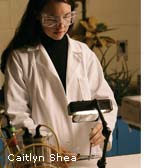 "We are definitely exploring in-line treatment," says Talley. "Using
enzymes, we could conceivably destroy the pathogens and reduce the
organic waste while it's in storage and before it's routed
to a treatment plant." Again, this process involves sensors embedded
in the system that would determine the type and location of the bacteria,
routing the information back to the base station. "We believe
this type of active control for the reduction of CSO events," says
Talley, "would require minor modification to existing sewer infrastructures,
making it a cost-effective means of meeting EPA mandates." "We are definitely exploring in-line treatment," says Talley. "Using
enzymes, we could conceivably destroy the pathogens and reduce the
organic waste while it's in storage and before it's routed
to a treatment plant." Again, this process involves sensors embedded
in the system that would determine the type and location of the bacteria,
routing the information back to the base station. "We believe
this type of active control for the reduction of CSO events," says
Talley, "would require minor modification to existing sewer infrastructures,
making it a cost-effective means of meeting EPA mandates."Notre Dame's approach to CSO control offers other benefits. A recent market analysis estimates that using embedded networks to address the CSO problem could bring 300 new jobs and more than $14 million annually to Indiana. The state would, in effect, become the national CSO service and products solution center. A host of spin-off projects could also evolve, such as the monitoring of biochemical agents for national security. It's interesting to note that some of the same health concerns that led to the creation of the Metropolitan Sanitary District of Greater Chicago in the late 1800s are still driving engineers and researchers. The emerging technology behind the CSO project has served to link academic institutions, corporations, and individuals in a quest to solve a national problem, one that will impact the quality of water and the quality of life. |
||
|
||
|

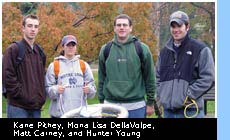 All 22 students in
Assistant Professor Jeffrey W. Talley's Introduction
to Environmental Engineering course participated in the LakeNet
assignment, an on-campus test of embedded network technology. The
purpose of the assignment was to involve undergraduates in hands-on
research, providing additional insight into the design challenges
faced by the research team working on the University's Combined
Sewer Overflow (CSO) project.
All 22 students in
Assistant Professor Jeffrey W. Talley's Introduction
to Environmental Engineering course participated in the LakeNet
assignment, an on-campus test of embedded network technology. The
purpose of the assignment was to involve undergraduates in hands-on
research, providing additional insight into the design challenges
faced by the research team working on the University's Combined
Sewer Overflow (CSO) project. Students faced a long list of other design challenges, including differences
in electrical current; most sensors work off 10V, while the motes housing the
sensors employ 5V. They also found that significant decreases in temperature
drained the batteries more quickly, something they had not considered. In spite
of such issues, the students learned a great deal about the mechanics of embedded
networks and the challenges in deploying this type of technology in the environment
... information that is now being used by the CSO team as they continue to develop
the sensors that will be deployed in the Clyde Creek Basin of the St. Joseph
River, the first full test of CSO/embedded network technology at Notre Dame.
Students faced a long list of other design challenges, including differences
in electrical current; most sensors work off 10V, while the motes housing the
sensors employ 5V. They also found that significant decreases in temperature
drained the batteries more quickly, something they had not considered. In spite
of such issues, the students learned a great deal about the mechanics of embedded
networks and the challenges in deploying this type of technology in the environment
... information that is now being used by the CSO team as they continue to develop
the sensors that will be deployed in the Clyde Creek Basin of the St. Joseph
River, the first full test of CSO/embedded network technology at Notre Dame.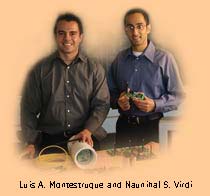 Montestruque specializes in theoretical issues related to real-time control of
networks. "My involvement in the CSO project began as a graduate student," says
Montestruque, "when Professor Lemmon was discussing the CSO project with
Professor Talley. The CSO team needed a company that could design and implement
the sensor hardware and software. My experience in designing embedded electronics
for industry paired with the CSO team's need to find a supplier seemed
like the perfect fit and a good basis on which to start a company."
Montestruque specializes in theoretical issues related to real-time control of
networks. "My involvement in the CSO project began as a graduate student," says
Montestruque, "when Professor Lemmon was discussing the CSO project with
Professor Talley. The CSO team needed a company that could design and implement
the sensor hardware and software. My experience in designing embedded electronics
for industry paired with the CSO team's need to find a supplier seemed
like the perfect fit and a good basis on which to start a company."
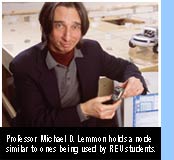 As with much of the
research conducted within the College of Engineering, the Combined
Sewer Overflow (CSO) project provides a wide range of hands-on
experiences for undergraduates during the academic year. Similar
programs also offer summer experiences funded by the National Science
Foundation. In summer 2005 juniors from across the country majoring
in engineering or biological sciences will participate in the first
summer Research Experiences for Undergraduates (REU) utilizing
embedded wireless sensor network technologies. As they address
the CSO issue, students will focus on two approaches: using an
existing sewer system to provide storage for overflow and for in-line
treatment of waste.
As with much of the
research conducted within the College of Engineering, the Combined
Sewer Overflow (CSO) project provides a wide range of hands-on
experiences for undergraduates during the academic year. Similar
programs also offer summer experiences funded by the National Science
Foundation. In summer 2005 juniors from across the country majoring
in engineering or biological sciences will participate in the first
summer Research Experiences for Undergraduates (REU) utilizing
embedded wireless sensor network technologies. As they address
the CSO issue, students will focus on two approaches: using an
existing sewer system to provide storage for overflow and for in-line
treatment of waste.